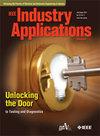3D打印表面纹理对聚合物平板共形接触摩擦充电过程的影响
IF 4.5
2区 工程技术
Q2 ENGINEERING, ELECTRICAL & ELECTRONIC
引用次数: 0
摘要
聚合物在利用摩擦电效应的工业应用中经常用作接触材料。本文的目的是研究在3D打印制造技术的帮助下,聚合物的摩擦充电如何受到其表面形态的影响。实验使用线性摩擦计通过两个样品之间的摩擦产生电荷。为了突出表面纹理与摩擦电荷水平的相关性,制造了三种不同表面几何形状的聚乳酸(PLA)样品,称为“线条”,“之字形”和“波浪”。第一个系列的实验是在摩擦充电台上用铝棒对PLA样品表面进行20和40个循环的充电。然后使用二维制图系统夹带静电电压表的电容探头,对表面的电势进行制图。在第二组实验中,经过摩擦充电后,将PLA样品置于静电电压表探头下10min,测定表面电位衰减(SPD)曲线。“线”纹理样品的表面电位值范围比其他两种样品小,这表明纹理的几何形状显著影响摩擦电荷的结果。对比三种纹理在20次循环下的SPD曲线,可以发现“线”型和“之”型PLA的SPD曲线基本相同,但与“波”型样品的SPD曲线不同。本文章由计算机程序翻译,如有差异,请以英文原文为准。
Influence of 3D Printed Surface Texturing on the Tribocharging Process of Polymer Slabs in Conformal Contact
Polymers are frequently used as contact materials in industrial applications that exploit the triboelectric effect. The aim of this paper is to investigate, with the help of 3D printing manufacturing technologies, how tribocharging of polymers is affected by their surface morphology. The experiments were performed using a linear tribometer to create the electric charge through friction between two samples. To highlight the correlation of surface texture with the level of triboelectric charge, the Polylactic acid (PLA) samples were manufactured with three different surface geometries, referred to as “lines”, “zigzag” and “waves”. The first series of experiments consisted in charging the surface of the PLA samples with the tribocharging bench for 20 and 40 cycles, with an Aluminum bar. The cartography of the electric potential at the surface was then performed, using a 2D mapping system to entrain the capacitive probe of an electrostatic voltmeter. In the second series of experiments, after tribocharging, the PLA samples were placed under the probe of the electrostatic voltmeter for 10 min to determine the surface potential decay (SPD) curve. The range of surface potential values was smaller for the “lines”-textured samples than for the other two, pointing out that the geometry of the texture significantly influences the outcome of the triboelectric charging. When comparing the SPD curves of the three textures for 20 cycles, it can be noted that ones for PLA with “lines” and “zigzags” are almost the same, but different from those of “waves”-type samples.
求助全文
通过发布文献求助,成功后即可免费获取论文全文。
去求助
来源期刊

IEEE Transactions on Industry Applications
工程技术-工程:电子与电气
CiteScore
9.90
自引率
9.10%
发文量
747
审稿时长
3.3 months
期刊介绍:
The scope of the IEEE Transactions on Industry Applications includes all scope items of the IEEE Industry Applications Society, that is, the advancement of the theory and practice of electrical and electronic engineering in the development, design, manufacture, and application of electrical systems, apparatus, devices, and controls to the processes and equipment of industry and commerce; the promotion of safe, reliable, and economic installations; industry leadership in energy conservation and environmental, health, and safety issues; the creation of voluntary engineering standards and recommended practices; and the professional development of its membership.
 求助内容:
求助内容: 应助结果提醒方式:
应助结果提醒方式:


